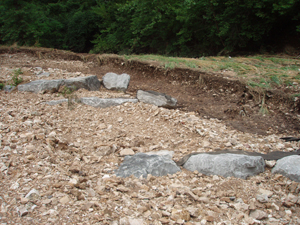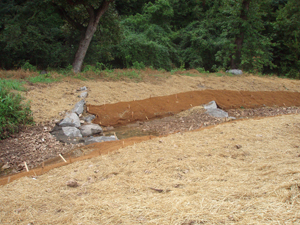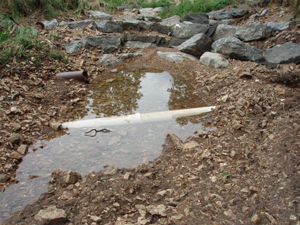Flooding in Tahlequah Swamps Streambank Stabilization Site

On July 29, 2013 the City of Tahlequah received six inches of rain in nine hours. This put unusual stress on local waterways, including a recently stabilized streambank at Kaufmann Park. The site was part of the Illinois River Watershed Erosion Control Project completed in October 2012.
A flash flow within the stream channel was forceful enough to move cobble, shift boulders, and erode banks. Although the damage appeared significant, a closer look revealed structures installed during the 2012 project were not damaged. However, a sewer line had been exposed, which required immediate attention.
The original designer, Stantec, arrived to access the damage and make recommendations. The U.S. Army Corps of Engineers was consulted for permitting and by August 5, Northstate Environmental had arrived to move dirt so work could begin. The first order of business was to remove trees planted to stabilize the bank in 2012. This allowed workers and equipment to access the site for repairs.

Oklahoma Conservation Commission Water Quality staff dug up trees, wrapped their roots in burlap, and placed each in an adjacent pond area to await replanting after the streambank site was restored.
The City of Tahlequah promptly secured the exposed sewer line by encasing it in several inches of concrete, then Northstate Environmental began the repair work. They secured the boulders in each cross vein or weir by re-positioning them and packing around them with cobble. In one area, where water had flowed over the bank and into the channel from a playground area, the cross vein was tied into the bank to accommodate this type of heavy flow.
A bench was created on the inside of the bend, which will allow future flood waters to gradually rise and recede without eroding the bank. The channel outlet, which feeds into Town Branch Creek, was clogged with cobble during the flood event. As part of the repair, the cobble was removed and flow restored.

Once the dirt work was finished, millet and fescue seed were broadcast and straw spread to cover the disturbed soil. The final step was to replant the trees whose roots will anchor the soil. Inmates from the Cherokee County Department of Corrections assisted with the replanting.


Repair activities took a total of one week. The Conservation Commission and partners learned from the event by seeing what parts of the 2012 project withstood the flash flood and what aspects needed reinforcing to, hopefully, handle such an event in the future.
